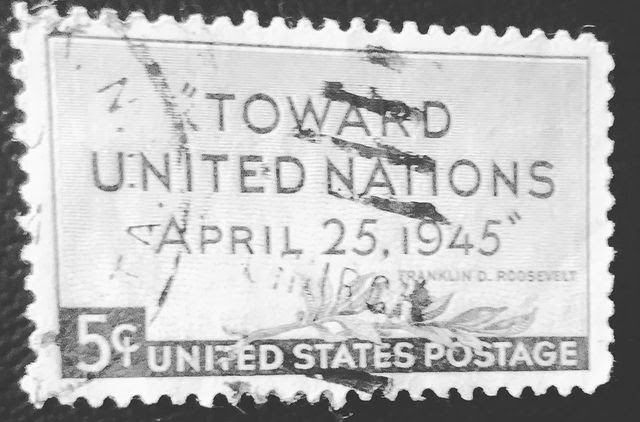Towards United Nations stamp – United States was issued in commemoration of the United Nations Conference on International Organizations. This 5-cent blue stamp was issued on April 25, 1945.
This conference is generally recognized as the founding of the United Nations. The stamp design is dominated by the quotation, “Toward United Nations April 25, 1945,” attributed to President Franklin D. Roosevelt.
About United Nations
The United Nations is an intergovernmental organization whose stated purposes are to maintain international peace and security, develop friendly relations among nations, achieve international cooperation, and serve as a centre for harmonizing the actions of nations. It is the world’s largest international organization. The UN is headquartered on international territory in New York City, and the organization has other offices in Geneva, Nairobi, Vienna, and The Hague, where the International Court of Justice is headquartered.
The UN was established after World War II with the aim of preventing future world wars, and succeeded the League of Nations, which was characterized as ineffective. On 25 April 1945, 50 nations met in San Francisco, California for a conference and started drafting the UN Charter, which was adopted on 25 June 1945. The charter took effect on 24 October 1945, when the UN began operations. The organization’s objectives, as defined by its charter, include maintaining international peace and security, protecting human rights, delivering humanitarian aid, promoting sustainable development, and upholding international law. At its founding, the UN had 51 member states; as of 2023, it has 193 – almost all of the world’s sovereign states.
The organization’s mission to preserve world peace was complicated in its early decades due in part to Cold War tensions that existed between the United States and Soviet Union and their respective allies. Its mission has included the provision of primarily unarmed military observers and lightly armed troops charged with primarily monitoring, reporting and confidence-building roles. UN membership grew significantly following widespread decolonization in the 1960s. Since then, 80 former colonies have gained independence, including 11 trust territories that had been monitored by the Trusteeship Council. By the 1970s, the UN’s budget for economic and social development programs vastly exceeded its spending on peacekeeping. After the end of the Cold War in 1991, the UN shifted and expanded its field operations, undertaking a wide variety of complex tasks.
The UN has six principal operational organizations: the General Assembly, the Security Council, the Economic and Social Council, the International Court of Justice, the UN Secretariat, and the Trusteeship Council, although the Trusteeship Council has been inactive since 1994. The UN System includes a multitude of specialized agencies, funds, and programmes, including the World Bank Group, the World Health Organization, the World Food Programme, UNESCO, and UNICEF. Additionally, non-governmental organizations may be granted consultative status with the Economic and Social Council and other agencies.
The UN’s chief administrative officer is the secretary-general, currently Portuguese politician and diplomat António Guterres, who began his first five year-term on 1 January 2017 and was re-elected on 8 June 2021. The organization is financed by assessed and voluntary contributions from its member states.
Interesting facts about United Nations
1. The Universal Declaration of Human Rights is the first document to detail the fundamental human rights that must be protected. The declaration was proclaimed by the General Assembly in 1948. Security human rights is a key pillar of the UN’s work.
2. The annual UN Peacekeeping budget is less than 0.5% of global military spending. The UN currently has more than 100,000 peacekeepers helping keep peace in 13 operations on 3 continents.
3. The UN’s World Food Programme (WFP) provides food and assistance to some 115.5 million people in 84 countries. Additionally, WFP is planning for the future by developing programs to ensure a more stable food environment.
4. The UN and its agencies assisted in 1.9 million safe deliveries from 2018 – 2020. The UN Population Fund (UNFPA) works to make motherhood safer, among other responsibilities.
5. The UN and its agencies supply vaccines all over the world. For example, as of September 2021, the UN’s partnership with Gavi had led to 5.5 billion doses of the COVID-19 vaccine being administered worldwide.
6. The UN supported over 50 member states with their elections in 2020. The UN also uses diplomacy to prevent conflict.
7. The UN assists people displaced by violence, conflict, and persecution. The UN and its agencies provide life-saving help to refugees and forcibly displaced people. Today, there are more than 82.4 million forcibly displaced people.
8. The Paris Agreement on climate change was signed by the largest amount of countries ever in a single day. On Earth Day 2016, 174 world leaders signed the agreement at the UN headquarters in New York. The UN is committed to fighting climate change, and the agreement builds on the UN Framework Convention on Climate Change.
9. The UN brought countries together in 2015 to launch a plan to end poverty, reduce inequalities, and protect the planet by 2030. The Sustainable Development Goals provide a common blueprint for countries to reach a world of dignity for all by 2030.
About the stamp
Towards United Nations stamp – United States was issued in commemoration of the United Nations Conference on International Organizations. This 5-cent blue stamp was issued on April 25, 1945.
This conference is generally recognized as the founding of the United Nations. The stamp design is dominated by the quotation, “Toward United Nations April 25, 1945,” attributed to President Franklin D. Roosevelt.
A laurel branch below the quote is the only pictorial element in the design.
